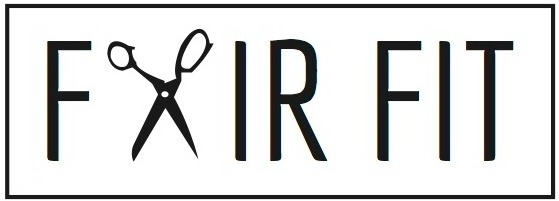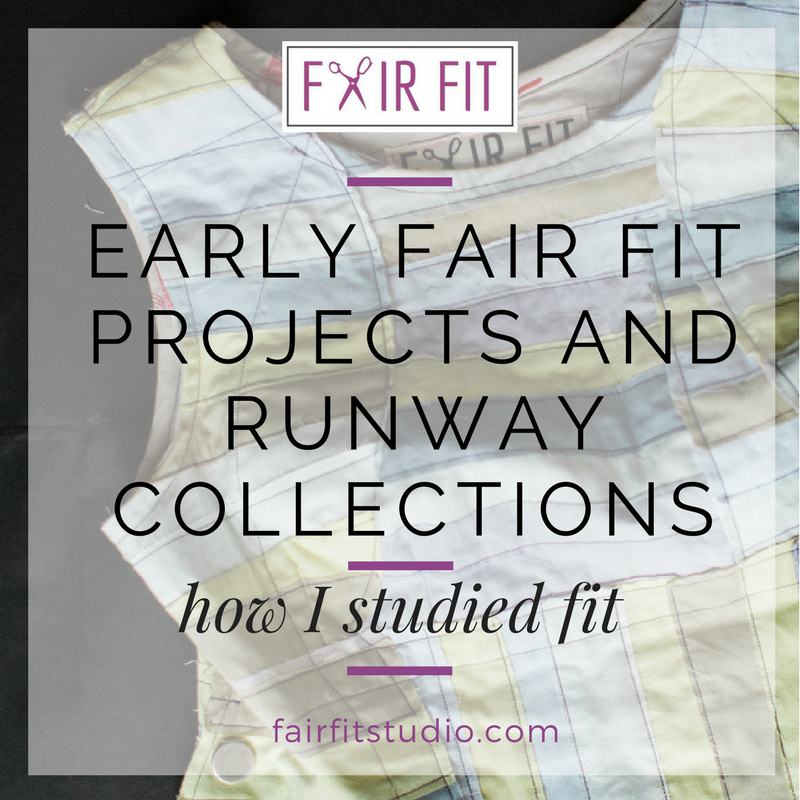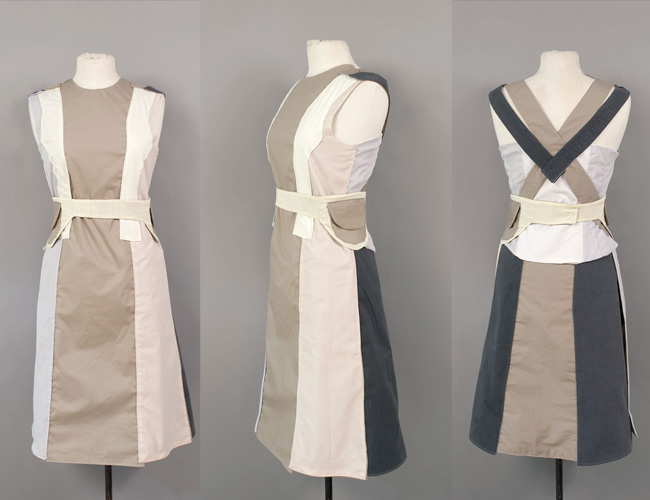Early Fair Fit Projects and Runway Collections
Welcome Back! Thank you for reading this series where I'm discussing how I formed the name Fair Fit, and what it means to me from the perspectives of "fair fashion."
To pick up from where I was at in the story, last week I discussed how in my first collections and forays into the business of fashion, I was learning to work with input from other people along the way. As a maker, I was frustrated that the exchange of my product could come down to small nuances of "I like it but...." and I was overwhelmed as to what to do with input and advice as to what and how I should be creating. When you are a maker, and you grow an audience, you will get input if you are doing anything worthwhile that activates other people, and last week I explained how of course, that's not a bad thing.
But by making and selling clothing within the existing standards of design, patterns, and systems to reach other people, I felt unable to see solutions to the feedback within those pre existing systems of design and exchange. When you are looking at what already exists- it's cooked, finished, and it's someone else's idea.
At that time, retail operated similarly, there was an established way that a client and a designer experience the process of a sale. I couldn't see how operating in the existing system back in 2005/6 was ever going to solve all of the proposals and feedback I was receiving as to how more people wanted to actually experience and wear my designs.
What I was learning as a business owner was that you could lose a sale based on the length of a sleeve, or nuances in the grade of your sizing, and many more reasons because of the standardization of clothing. Those reasons are still valid today. That's pretty tough to swallow, when you consider that a fashion line produces inventory, investing labor and materials into a garment before the sale is made. Even if you are the only one producing your clothing, if the garment doesn't sell, that's a loss of time, money, and materials.
And what I was learning as a human and designer was that existing fashion did not serve enough people, and made lots of people feel excluded. Participating in this part of the industry and operating from the existing models of what stores needed to sell, was challenging as I had to consider that what I made was being informed and limited by working in the existing models of exchange.
And as I entered graduate school, I was thrown into the ongoing conversations as to the issues of fashion and why the current production systems are unethical. This was 2007, and already the sustainable fashion movement and a full fledged critique on fast fashion had begun. Many of my professors had written and published books and articles on the topics of labor and craft, and here I am just coming out of this heavily criticized field. And as I confessed last week, I'm not always the best at receiving critique, especially if it seems impossible to make better.
I took a break making garments
Looking back, I can really see that to take a break was the best move I could make at the time. I knew a lot of reasons why fashion has the potential to enthrall some and exclude others. But to think a creative work can make everyone happy is an impossible, idealistic assumption to entertain. What I really wanted was an open conversation, a fair exchange, and both parties could respectfully have a great collaboration, or also part ways without hurting each other's feelings.
If you are being a good designer, and thinking and acting very specifically and intentionally, then really your work is going to be worn by the people it can effectively serve. In my case, due to the nature of how I pursue design, that's a really small number. By trying to mass produce it, or make something everyone is going to like then likely you will turn to what already exists and been proven. The problem there is you are watering down your voice and specificity.
How can we make space for open conversation?
So what I began to explore was how to bring more client participation to the design process. Instead of folks telling me how to make it, could I provide opportunities for them to have a part in the making? Could I provide enough opportunities for customization, within my own capacity for design, for more perspectives and stories to emerge?
What I considered was that most of the time, the critique of fashion comes down to fit, and whether the garment is suitable, comfortable, and flattering for your unique body type. In my first clothing collections I gathered that if someone likes your garment, its style, fabric, and its expression, but still rejects it- usually it comes down to a fit issue. I could work with that- it meant that the client likes about 80%, and that other 20% of "I like it but..." created an opening. What I can't work with is if you just don't like the aesthetic, that's 80% and you can't really change that without deciding you will manufacture other people's ideas and vision.
But that 20% opportunity to play with fit could be interesting.
I thought about how there are really 7 common complaints, and where those complaints were located on the body. Necklines, bustlines, sleeves (oh sleeves are such a beast), waistlines, hemlines, the amount or lack of fullness, and the backside. And I went to my pattern blocks, drafted in the presumed shapes of clothes that we have seen for decades, and I broke them into fragments.
They became workable parts
I was at an art school, so I had the freedom and was definitely pushed to make something that was unlike what had been seen before. My teachers were invested in my growth and unique voice, and they did not want to see a street dress from me or anything you would see in a fashion magazine. It already exists, so therefore, it was irrelevant because my voice was not present.
I was pushed to make something new. I started by creating a system consisting of base panels to cover the body built off the princess seam style line, and component parts that would allow the wearer to play with the fit. They could add and subtract fullness, and emphasize areas of the body that they chose to emphasize.
And the exchange would take place in an installation with the pieces installed so that you can see them and work with them, and put together a dress with me.
One of the First Fair Fit System Installations. Chicago, 2009
A First Fair Fit Dress, Created by a Client Using the Fair Fit System. Chicago, 2009
While limited in that it was still my aesthetic in terms of fabric, and the availability of parts, when I had these exchanges I learned a lot about how people think about their bodies and relationships to clothes. What I didn't know was most of the time the everyday person doesn't want to go through all of that trouble to really express themselves with clothing. And I don't blame them. While the idea of "inefficient" or "slow" retail was an expression to counteract "fast fashion," sadly the reason fast fashion exists because its easy, efficient, and accessible when you don't have time, or want, to think about the issues it presents.
I learned a lot, and this work was supported by my community in Chicago. However, unless I went down a path of grant writing and academia, there was not really much of an audience for it. It was a great conversation, but I still needed to define what kind of professional life I wanted to have, and really I was a business builder at heart.
So I put the project away, and returned to New Orleans
Could I keep the collaborative aspect and still preserve the conversation and opportunity for folks to have choice in their clothing? And find some way to speed this up?
I broke the pattern down further, and actually simplified it. I created my own math of built in grading to eliminate the need for panels, and I removed all components. The pieces would fit together by overlapping intentionally and fit could be achieved by using the princess seam and strategic darts. I also payed attention to common silhouettes, like pencil, A-line, and circle skirts, as well as how people fit the bust and waist. I made several interpretations, but at the core there was one Fair Fit dress that was the pattern from which the others were built.
I also knew that when you don't know fashion design, a bunch of abstract parts is overwhelming and intimidating. Most people want to see an example as a base, and then work from there. So I made lots of Fair Fit dresses, and needed to find a way that they would be seen, hopefully to inspire people to come and make a their own dress with me.
Fair Fit Sample Dress. New Orleans, 2012
Back in Post Katrina New Orleans, I made the decision to return to creating shows, and this time, I participated in runway shows.
Fair Fit Runway and Presentations
This became a time that informs my perspective to the present in how I practice creatively and professionally. It also brought incredible blessings into my life, like finding my husband Paul. I loved this time in my trajectory of work because it was so exciting, and full of potential, and because I was walking into unclear territory.
I'll preface this time in order to explain how I was creating mixed results in my work by confessing I was becoming very stressed out. It's one thing to be a 20 something with no student loan debt and not a lot of financial responsibilities, it's a whole other existence to be a 30 something which HUGE student loan debt from grad school and a lot more financial burdens.
At this time, I was looking for the Fair Fit dresses to start selling, and I wanted to work with other people and their systems for how it enters the world in order for my work to reach an audience who would buy my clothing.
Fair Fit Spring/Summer. New Orleans 2013
Runway was a platform for expression of the powerful narratives with clothing, hair, makeup, and styling. It's really exhilarating, because all of the resources of talent, people, and ideas are all in one place, and over 50 people would collaborate at one time. And at that time, everyone involved in our fashion week was working from the potential that high fashion and it's community could thrive in the "New" New Orleans. It was really inspiring, and we all wanted to be there to make it happen.
Fair Fit Spring Summer. New Orleans 2011
The unsustainable part of it was that the New Orleans fashion scene was in infancy, it was just starting to attract potential buyers. And even though I received supportive reviews, and lots of press, and Anthropologie was interested, I really wasn't a good fit for the platform and for buyers because I could not produce these dresses in a factory.
Thinking I could do so went against the original "inefficiency" that the dress was built on anyway. And I had to make all the dresses in sample sizes, which meant the whole customization of the sizing was totally missed. In order for me to participate in that existing system and to produce more quantities, the whole idea was compromised. And I was compromising my original ideas. That did not feel good and its no wonder my results were mixed.
I entertained the idea that they could just be small one offs, offered at independent boutiques like my first collection. But I had to recognize that times had changed. And I'd need to produce some sort of minimum to make it worth it, and fair, to everyone.
Fair Fit Fall/Winter. New Orleans 2012
I felt really stuck. I couldn't produce it sustainably, even with just my own labor. I had a teacher at the time who advised me that sometimes when we are clutching too tightly to the idea of how of how our project is prospered, we leave no room for inspiration. And she gently advised me to give it a rest for awhile, to let some new info come through.
Good things came next, and it helped me learn more core perspectives and definitions into "fair fashion."
Update: Do you want to see where the project is now?
Have you heard of my signature fashion design online courses, The Fair Fit Method? It's a series of courses designed to teach you intermediate to advanced fashion design skills like padding a form to your shape and size, fashion draping, pattern alteration, and adaptations for custom design. Enrollment happens only 3 times a year. If you would like to learn more about these courses and possibly take a class with me yourself go here to learn more:
In my next post, I'll share how I took my knowledge of sewing, pattern, and fit to work in the professional world. I learned key perspectives about fashion, fit, and fairness back then that are really pivotal to my life now and want to share some perspectives of how fair fashion exists far beyond just how clothes are made.
See you next week!












